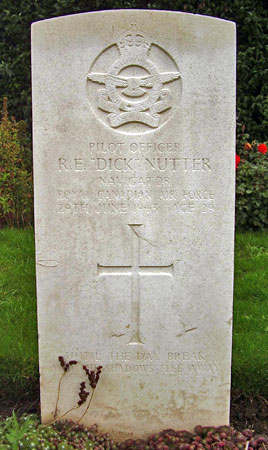On 29th June 1943 the crew of this 1659 Heavy Conversion Unit aircraft were to undertake a cross-country training flight when the port outer engine caught fire immediately on take off. The crew managed to climb to around two hundred feet when the crew attempted to feather the failed engine but this did not work. The aircraft had not gained enough airspeed so began to lose height. At 10.52hrs a crash landing was made in a field near Crosby Manor Farm, Thornton le Beans but sadly two of the crew were killed. An investigation for that the engine fire was caused by the failure of the big end baring inside the engine.
Navigator - P/O Richard Eric Nutter RCAF (J/17555), aged 29, of Toronto, Ontario, Canada. Buried Dishforth Cemetery, Yorkshire.
Wireless Operator / Air Gunner - Sgt Raymond Crookes RAFVR (1455496), aged 21, of Sheffield. Buried Crookes Cemetery, Sheffield, Yorkshire (Sec JJ, grave 6101).
Survived were..
Pilot - F/Lt David James Corcoran RCAF (C/4328).
Air Gunner - Sgt Jack Tony Venier RCAF (R/152678).
Bomb Aimer - P/O Leslie Charles Edgar Webley RCAF (J/21610).
Flight Engineer - Sgt Clifford William Holdsworth RAFVR (1545876).
Air Gunner - P/O Darrell Emmerson Larlee RCAF (J/14743).

Richard Nutter was born on 9th February 1911 at London, Ontario, Canada and was the son of Arthur Edward and Amy (nee Nayler) Nutter. Both his parents were born in England but emigrated to Canada. As a young man Richard started work for the T.Eaton Company Ltd in Toronton in 1927 as a carrier and office boy and worked his way up be a salesman and section head. While working there he undertook a number of training courses. He studied at the Canadian School of Commerce, the Marconi School of Wireless and other business courses in the 1930s. He enlisted for RCAF service on 18th July 1941 at Toronto and after training in Canada was awarded his air observer's flying badge on 23rd May 1942. He arrived in the UK in August 1942 and after traini.ng at 1 (O)AFU and 22 OTU. While training at 22 OTU he was involved in a minor accident on 5th December 1942 while in Wellington HF647 it bounced on landing and overshot the boundary, coming to rest in a ploughed field. On the Form 765c he is listed as being a trainee pilot but this must be an error. He was posted to 420 Squadron on 5th January 1943 and would receive a commission on 2nd May 1943. He then was posted to 1659 HCU on 24th May 1943 and to 419 Squadron four days later but then back to 1659 HCU on 24th June 1943.
David Corcoran was a very experienced pilot with nearly 1500 hours flying to his name when this incident occurred, his experience was however not on the Halifax type, he had only twenty six hours to his name on this type. He and P/O Larlee completed their training and were posted to 419 Squadron, on 31st August 1943 they were part of a crew flying Halifax JD331 on an operational flight to Berlin when the aircraft was shot down by a nightfighter. Both survived but were taken prisoner.
Sgt Holdsworth was soon posted to 429 Squadron but was killed on 5th October 1943 when Halifax JD327 was attacked by an enemy aircraft, with bullets killing him. He is buried at Leeds (Armley) Cemetery, Yorkshire.
Jack Venier was posted to 419 Squadron on 4th July 1943 and then to 405 Squadron on 10th October 1943. On 11th May 1944 he was deemed medically unfit for service and would be discharged from the RCAF on 28th September 1944 but then died on 20th April 1945. He is buried at Winnipeg Assumption Gardens, Canada.

Darrell Larlee was born in Bath, Carleton County, New Brunswick on 19th May 1912 and attended Mount Allision University before beginning work for the Fraser Company Ltd in the forests of New Brunswick and Quebec. At the ripe old age of twenty eight he enlisted into the RCAF in early 1940 to become a pilot but was not accepted so was posted to a ground role. In 1941 he tried to become aircrew again and was accepted as an air gunner, he did well in training and passed out commissioned. He was posted overseas in late-1941. After further training in the UK (which involved this accident at Thornton le Beans in Halifax DT553) he was eventually posted to 419 Squadron. He had completed eighteen operational flights before 31st August 1943 when he, along with F/Lt Corcoran (his pilot in DT553) were undertaking ops to Berlin when their aircraft, Halifax JD331, was shot down by a night-fighter. He and Corcoran survived but were captured and taken prisoner of war. He found himself in the Sagan PoW camp, made famous for the Great Escape break-out resulting in fifty escapees being murdered. Larlee took an active role in the tunnel digging but could not take part in the break-out because he was suffering from a leg injury at the time. He saw out the war as a PoW and eventually returned home to Canada returning to working for the company he left in 1940. He died in 1993, aged 83.
P/O Webley completed his training and was posted to 431 Squadron. He was sadly killed when Halifax LK884 on 9th May 1944. The aircraft was shot down by a night fighter and crashed near Rance, Belgium and he is buried at Gosselies Communal Cemetery, Belgium.

In September 2004 historians Eric Barton, Ken Reast and Albert Pritchard sought permission from the landowner for a field walk across the area of where this aircraft was believed to have crashed. Small fragments were found but enough to confirm the location both of the initial impact and where it came to rest. The photograph above was taken by Eric Barton and shows the area of their finds.